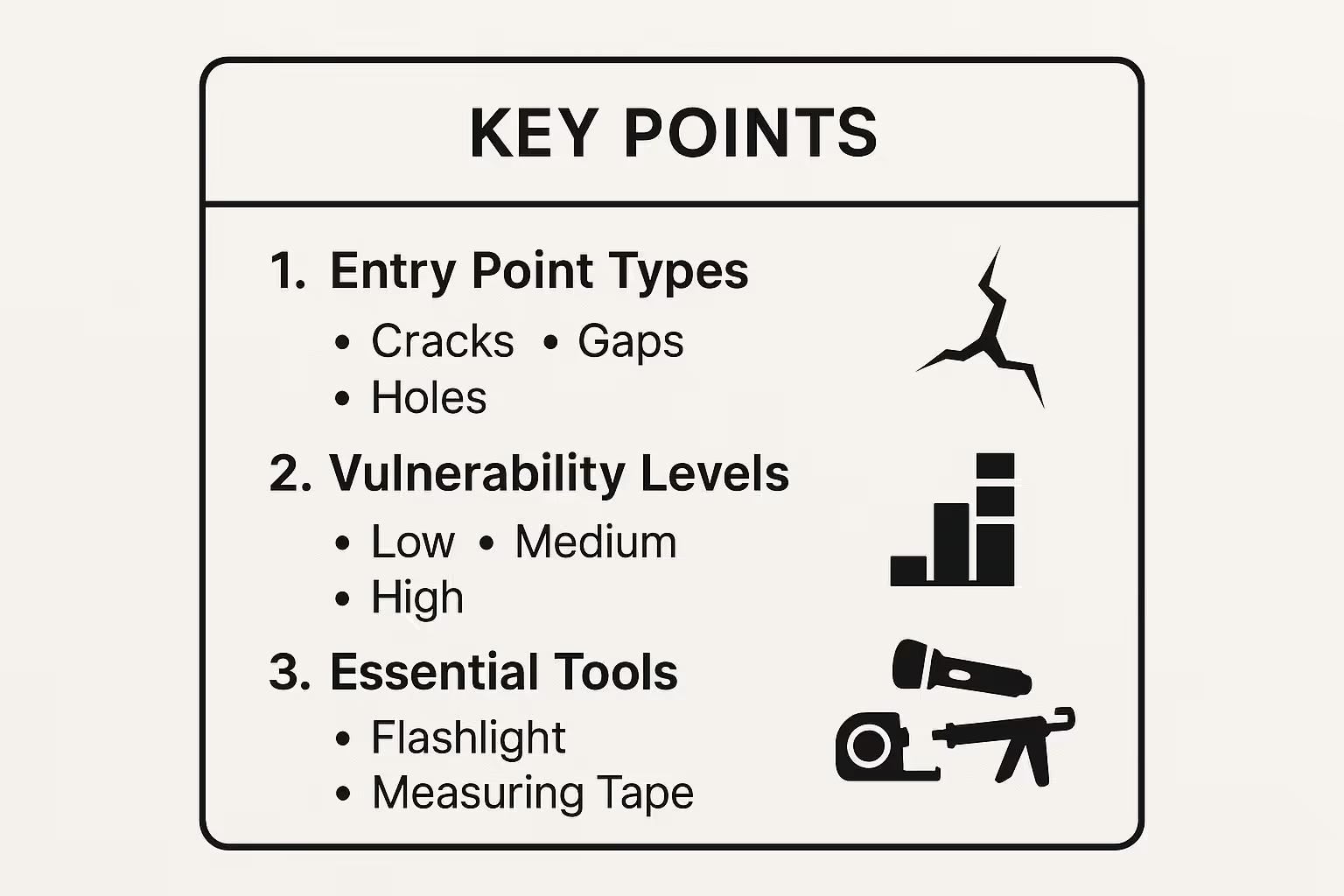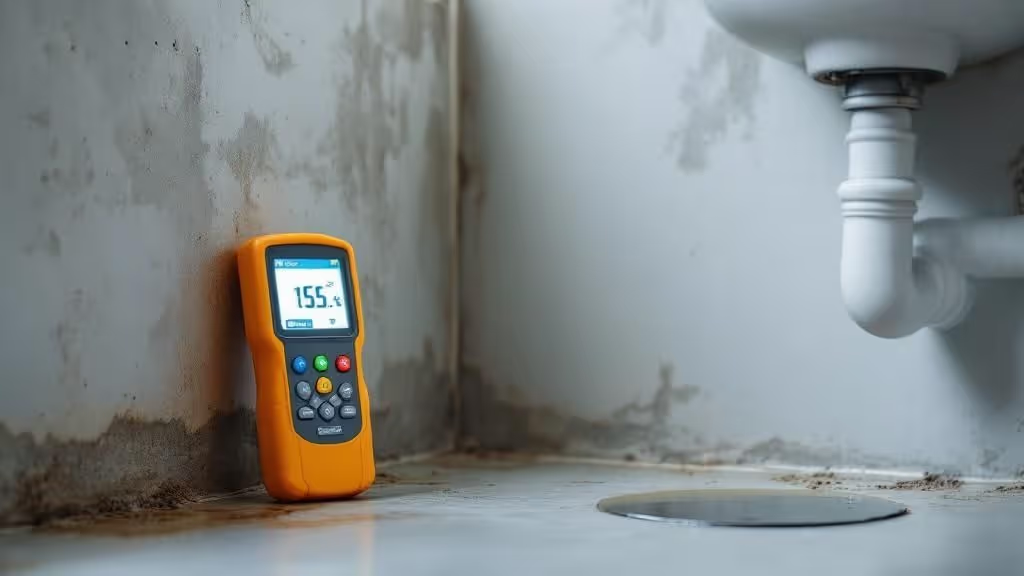In the world of property management and homeownership, overlooking small details can lead to significant problems. Pests are not just a nuisance; they are a direct threat to structural integrity, occupant health, and financial stability. A superficial look-around will not uncover the hidden vulnerabilities that allow infestations to take root and flourish. This is precisely why a methodical, comprehensive pest control inspection checklist is an indispensable tool for any technician or property manager. It transforms a simple walkthrough into a strategic assessment, moving beyond just spotting pests to proactively identifying and eliminating the conditions that attract them in the first place.
This guide provides an in-depth, 8-point checklist designed for both commercial and residential properties, ensuring you have a systematic framework for a truly effective inspection. A proper evaluation requires more than a quick glance; it demands a structured approach to uncover potential risks before they escalate into costly emergencies.
We will break down each critical inspection area, providing the actionable steps, real-world examples, and specific details needed to fortify your property against unwanted intruders. By the end of this article, you will be equipped to conduct inspections that not only solve current issues but also prevent future ones. This detailed pest control inspection checklist is your roadmap to saving time, money, and stress in the long run by addressing the root causes of pest problems, not just the symptoms.
1. Entry Point Identification and Sealing
A pest control inspection checklist must begin with the most fundamental and proactive step: identifying and sealing all potential entry points. This process involves a meticulous examination of the building’s exterior and interior to find every crack, gap, and opening that could allow pests inside. By addressing access, you move from a reactive "kill" strategy to a preventative "exclude" strategy, which is far more effective and sustainable long-term.
Think of your building as a fortress. Any breach in the walls, foundation, roof, or utility lines is a potential gateway for invaders. This foundational step is crucial because it tackles the root cause of infestations. Without access, pests cannot establish a presence, seek shelter, or find resources within your property.
The Systematic Approach to Exclusion
A thorough inspection requires a systematic walk-around of the property, both inside and out. The goal is to map every vulnerability where pests could infiltrate.
- Foundation and Walls: Examine the foundation for cracks, especially where it meets the siding. Check for gaps around vents, spigots, and utility penetrations for pipes, electrical wiring, and HVAC lines.
- Windows and Doors: Inspect window frames and door sweeps for wear and tear. Damaged weather stripping or a gap under a door is an open invitation for rodents and insects. Properly sealed and well-maintained exterior doors are paramount to preventing pest intrusion. If your current doors are damaged or show signs of wear, consider consulting professional exterior door services to upgrade your defenses.
- Roof and Soffits: Check for damaged shingles, gaps in the soffits, and unprotected vents. Birds, squirrels, and raccoons often exploit these high-access points.
Pro Tip: Major corporations understand the power of exclusion. McDonald's enforces strict entry point sealing protocols across its restaurants, and Disney World maintains detailed "exclusion maps" for its facilities to preempt rodent problems before they start.
This summary highlights the essential elements of entry point identification for your pest control inspection checklist.

As the infographic shows, focusing on the types of openings, their vulnerability levels, and having the right tools on hand makes the process manageable and effective. By documenting and prioritizing these points, you can systematically fortify your property against pests.
2. Moisture and Water Source Assessment
A comprehensive pest control inspection checklist must prioritize the identification and elimination of excess moisture. Pests, like all living organisms, require water to survive and thrive. By systematically assessing and controlling moisture sources, you remove one of the three key elements pests need: water, food, and shelter. This step is critical because many pests, including cockroaches, rodents, termites, and silverfish, are strongly attracted to damp environments.

Managing moisture is about more than just fixing dripping faucets. It involves evaluating humidity levels, condensation, drainage, and hidden leaks that create ideal breeding grounds. A dry property is an inhospitable one for most common pests, making moisture control a powerful preventative measure that directly impacts their ability to establish an infestation.
The Systematic Approach to Moisture Control
A thorough moisture audit involves inspecting areas prone to water accumulation. The goal is to identify and resolve these issues, making the environment less attractive to pests.
- Interior Wet Areas: Regularly inspect under sinks, around toilets, and near water-reliant appliances like refrigerators and washing machines. Look for signs of leaks, water stains, or mildew.
- Basements and Crawl Spaces: These areas are notorious for dampness. Check for standing water, condensation on pipes, and efflorescence on walls, which indicates moisture seeping through the foundation.
- HVAC and Drainage: Ensure HVAC drain lines are clear and functioning correctly. Check that exterior grading slopes away from the foundation and that gutters and downspouts are not clogged, preventing water from pooling near the building.
- Humidity Monitoring: High humidity can create a welcoming environment for pests. Monitor relative humidity levels, aiming to keep them below 60% through proper ventilation, dehumidifiers, or HVAC system adjustments. Beyond obvious leaks, addressing foundational damp is critical. Consider exploring professional damp proofing solutions to eliminate hidden moisture sources that attract pests.
Pro Tip: Leading organizations use targeted moisture control as a core pest management strategy. Marriott Hotels conducts quarterly moisture assessments in all guest rooms and common areas, while Whole Foods Market implements comprehensive moisture monitoring in produce sections to prevent pest issues before they arise.
This summary underscores the importance of a detailed moisture assessment in your pest control inspection checklist. By methodically identifying and addressing water sources, you can significantly reduce your property's vulnerability to pests.
3. Food Source and Waste Management Evaluation
After securing entry points, the next critical item on any pest control inspection checklist is a thorough evaluation of food sources and waste management practices. Pests invade properties for three primary reasons: food, water, and shelter. By systematically eliminating their access to food, you remove one of the most powerful attractants and significantly reduce the likelihood of an infestation taking hold.
This step involves a detailed inspection of all areas where food is stored, prepared, served, and disposed of. It’s a foundational element of Integrated Pest Management (IPM) because it addresses the root cause of why pests are present in the first place. Without a reliable food source, pest populations cannot sustain themselves or thrive, making other control methods far more effective.

A Systematic Approach to Sanitation
A proper evaluation requires a methodical check of all food-related zones. The goal is to identify and correct any condition that provides nourishment for pests like rodents, cockroaches, ants, and flies.
- Kitchens and Pantries: Inspect food storage areas for open containers, spills, and crumbs. Ensure dry goods like flour, sugar, and cereals are stored in airtight, pest-proof containers made of glass, metal, or hard plastic.
- Dining and Break Areas: Check under and behind furniture and appliances for accumulated food debris. Clean up spills and crumbs immediately to prevent attracting opportunistic foragers.
- Waste Disposal: Examine interior trash cans and exterior dumpsters. Trash receptacles should have tight-fitting lids and be emptied regularly. Dumpster areas must be kept clean to avoid becoming a primary feeding ground for pests.
- Pet Food Areas: Don't overlook pet food stations. Store pet food in sealed containers and clean up any uneaten food promptly rather than leaving it out overnight.
Pro Tip: Major organizations build their brand reputation on cleanliness. Starbucks enforces rigorous "Clean, Safe, and Ready" protocols that include strict waste management and food storage rules. Similarly, hospital cafeterias and school districts implement detailed food source elimination procedures to comply with health codes and prevent pest-related health risks.
This summary highlights the critical role of sanitation in your pest control inspection checklist. By managing food and waste effectively, you create an environment that is inhospitable to pests, bolstering your property's defenses from the inside out.
4. Structural Condition and Maintenance Assessment
A comprehensive pest control inspection checklist must extend beyond surface-level checks to evaluate the building's overall structural integrity. This step involves a detailed assessment of the physical condition and maintenance of the property, as these factors directly create environments that harbor or attract pests. Issues like wood decay, foundation cracks, and roofing problems are not just maintenance concerns; they are critical vulnerabilities.
Think of your building’s structure as its immune system. When it’s compromised, it becomes susceptible to infestations. A deteriorating structure provides pests with shelter, moisture, and hidden pathways. Addressing these foundational weaknesses is essential for creating a long-term, pest-resistant environment and is a core part of any professional inspection.
The Systematic Approach to Structural Evaluation
A thorough structural assessment requires a methodical inspection of key building components, looking for signs of deterioration that could support pest activity. The goal is to identify and document any conditions that weaken the building's defenses.
- Wood and Timber Structures: Carefully examine all exposed wood, including beams, joists, and trim, for signs of termite mud tubes, carpenter ant galleries (frass), or wood rot caused by moisture. These conditions attract wood-destroying organisms.
- Foundation and Slabs: Inspect foundation walls and concrete slabs for cracks or fissures. Even small cracks can provide entry for insects and rodents, while larger ones can indicate significant moisture problems that attract a wide range of pests.
- Roofing and Attics: Check the roof, eaves, and attic spaces for damaged shingles, gaps, or holes that animals like squirrels, raccoons, or birds could exploit for entry. Ensure vents are properly screened. Beyond the obvious, don't overlook areas like drywall, where damage can indicate hidden issues or entry points; consider professional drywall repairs as part of your structural assessment.
Pro Tip: Property management companies for large commercial and residential portfolios conduct annual structural inspections as a standard pest prevention measure. They document everything from foundation cracks to roof integrity, creating a prioritized repair list to proactively eliminate pest-friendly conditions before they lead to infestations.
This summary highlights the essential elements of structural assessment for your pest control inspection checklist. By identifying and rectifying these deeper issues, you address the root causes of pest problems, making your property fundamentally less hospitable to invaders.
5. Vegetation and Landscaping Analysis
A comprehensive pest control inspection checklist must extend beyond the building's walls to the surrounding landscape. Vegetation and landscaping features can act as a bridge for pests, offering them food, shelter, and a direct pathway to your structure. An analysis of these outdoor elements is a critical preventative measure, disrupting the ecosystem that allows pest populations to thrive just steps from your door.
Think of your landscaping as the welcome mat for pests. Overgrown bushes, deep mulch, and tree branches touching the roof are not just aesthetic issues; they are invitations for ants, spiders, rodents, and termites. By managing the immediate outdoor environment, you create a buffer zone that makes it significantly harder for pests to approach and infiltrate the building. This step is vital for a holistic pest management strategy.
The Systematic Approach to Landscape Management
A thorough analysis involves evaluating how every element of your landscaping could support or deter pests. This requires a detailed inspection of plant life, ground cover, and water sources in relation to the building’s exterior.
- Proximity to Structure: Examine all vegetation near the building. Bushes, shrubs, and groundcover plants should be trimmed back to create a clear buffer zone of at least two to three feet from the foundation and siding.
- Tree Canopies and Rooflines: Inspect tree branches to ensure they are not overhanging or touching the roof. Rodents and insects use these branches as highways to access elevated entry points like vents, soffits, and chimneys.
- Mulch and Ground Cover: Assess the depth and condition of mulch beds. Excessive mulch (over three inches deep) retains moisture and provides ideal shelter for pests like termites, ants, and millipedes. Also, check for leaf litter and other organic debris that can harbor pests.
Pro Tip: Leading organizations integrate landscaping into their pest defense plans. Corporate campuses like Apple Park strategically use pest-resistant native plants in their designs, while large resort properties often have Integrated Pest Management (IPM) programs that specify landscaping maintenance protocols to minimize pest harborage.
This summary highlights the importance of vegetation management in your pest control inspection checklist. By actively managing your landscape, you eliminate key conditions that pests need to survive and gain access to your property.
6. Previous Treatment History and Documentation Review
A critical component of any professional pest control inspection checklist involves looking backward before moving forward. Reviewing previous treatment history and documentation provides invaluable context, revealing patterns, past failures, and successful interventions. This historical analysis allows a technician to understand the property's unique pest pressures and avoid repeating ineffective strategies. It’s the difference between starting fresh with no information and building upon a foundation of established knowledge.
Think of it as a patient's medical history for a building. Just as a doctor reviews past illnesses and treatments, a pest control professional uses service records to diagnose chronic issues and prescribe a more effective, targeted solution. This step is essential for identifying recurring problems, understanding seasonal trends, and recognizing potential chemical resistance that could undermine future efforts.
A Strategic Approach to Historical Analysis
A thorough documentation review transforms guesswork into a data-driven strategy. The goal is to piece together a complete narrative of the property's pest control journey to inform the current inspection.
- Service Record Scrutiny: Request and examine all past service records from previous pest control providers. Look for details on what pests were targeted, what chemicals or methods were used, and the dates of application.
- Mapping Past Activity: Correlate the locations of past treatments with current findings. Are the same areas repeatedly showing activity? This can indicate a persistent structural vulnerability or an unresolved environmental factor.
- Identifying Patterns: Analyze the records for seasonal pest emergence or recurring infestations. For example, noting annual ant problems in the spring allows for proactive treatment before the issue escalates.
- Assessing Effectiveness: Note which treatments worked and which did not. If a certain bait was ignored by rodents or a specific insecticide failed to control a roach population, this information is crucial for selecting a different approach.
Pro Tip: Leading industries rely heavily on this practice. Food processing plants are required to maintain exhaustive pest control logs to comply with food safety regulations, using the data to continuously refine their Integrated Pest Management (IPM) programs. Similarly, major hotel chains maintain centralized databases to track treatment history, ensuring consistency and effectiveness across all their properties.
This summary underscores the importance of historical data in your pest control inspection checklist.
Reviewing past documentation is not just about compliance; it is a strategic tool. By understanding what has been done, you can create a smarter, more efficient plan that addresses the root causes of pest problems, saving time, money, and frustration in the long run.
7. Monitoring and Detection System Evaluation
A comprehensive pest control inspection checklist must include an evaluation of your existing monitoring and detection systems. This step moves beyond passive observation and into active surveillance, providing critical data on pest activity, population levels, and movement patterns. Assessing these systems ensures they are working effectively and covering all high-risk areas, allowing you to catch infestations early before they become widespread problems.
Think of monitoring systems as your property’s early-warning network. Just as a smoke detector alerts you to a fire, properly placed traps and sensors alert you to the presence of pests. This proactive approach is essential for identifying vulnerabilities and measuring the success of your control efforts. Without effective monitoring, you are essentially flying blind, reacting to visible infestations rather than preventing them.
The Systematic Approach to Surveillance
A thorough evaluation requires a systematic review of all monitoring devices and protocols. The goal is to ensure your surveillance network is robust, strategically placed, and providing actionable intelligence.
- Placement and Coverage: Assess the location of all traps, bait stations, and electronic monitors. Are they positioned along likely pest travel routes, such as along walls, in corners, near food sources, and in dark, undisturbed areas? Gaps in coverage create blind spots where pests can establish themselves undetected.
- Device Condition and Functionality: Inspect each monitoring device for damage, contamination, or malfunction. Ensure that mechanical traps are set correctly, bait stations are stocked with fresh, non-toxic bait, and electronic sensors have functional batteries and are communicating properly.
- Data Collection and Analysis: Review the logs and data from your monitoring program. Are you consistently recording findings, including the type of pest, number caught, and location? This data is invaluable for identifying trends, pinpointing hotspots, and making informed decisions about where to focus control efforts.
Pro Tip: Modern facilities leverage technology for superior monitoring. Amazon warehouses use IoT-enabled systems that provide real-time alerts on pest activity, allowing for immediate response. Similarly, pharmaceutical manufacturing facilities employ comprehensive monitoring networks with detailed data analytics to meet strict regulatory standards and prevent product contamination.
This summary highlights the importance of evaluating your surveillance tools as a key part of your pest control inspection checklist. By ensuring your monitoring systems are optimized, you gain the critical insights needed to maintain a pest-free environment.
8. Environmental Conditions and Habitat Assessment
A truly comprehensive pest control inspection checklist must go beyond physical structures and delve into the ambient environment. This involves a thorough evaluation of environmental factors like temperature, humidity, lighting, and air circulation. These conditions create microclimates that can either deter pests or provide the perfect habitat for them to thrive, reproduce, and spread throughout a facility.
Think of your property not just as a physical space, but as an ecosystem. Subtle variations in environmental conditions can determine whether an area becomes a pest breeding ground or remains uninhabitable. Assessing these factors is crucial because it allows you to manipulate the environment to your advantage, making it less hospitable to pests and disrupting their life cycles. This proactive approach is fundamental to integrated pest management (IPM).
A Systematic Approach to Environmental Assessment
A detailed inspection requires measuring and analyzing the conditions that influence pest behavior. This goes beyond a simple visual check and involves a more scientific approach to identifying at-risk zones.
- Temperature and Humidity: Use a hygrometer to measure temperature and relative humidity in various locations. Focus on basements, crawl spaces, storage rooms, and areas near water sources. High humidity and warmth accelerate the development of many insects, like cockroaches and silverfish, and promote mold growth, which can be a food source.
- Lighting and Airflow: Assess lighting conditions in all areas. Some pests, like flies, are attracted to light, while others, such as bed bugs and rodents, prefer darkness. Evaluate air circulation, as stagnant air can lead to moisture buildup and attract pests. Poor ventilation in areas like kitchens and bathrooms creates ideal conditions for many common invaders.
- Monitoring Vulnerable Zones: Pay special attention to areas with unique environmental needs. Storage areas, boiler rooms, and spaces containing sensitive equipment often have distinct microclimates that can inadvertently support pest populations if not properly managed.
Pro Tip: Major institutions with sensitive assets rely on strict environmental controls. Museums precisely manage temperature and humidity to protect artifacts from pests like booklice and carpet beetles, while data centers implement rigorous environmental monitoring to prevent infestations that could damage critical electronic equipment.
This summary highlights the essential elements of environmental assessment for your pest control inspection checklist. By understanding and controlling these factors, you can create an environment that is inherently resistant to pest infestations.
8-Point Pest Control Inspection Comparison
Turning Your Inspection Checklist into an Actionable Strategy
The journey through a comprehensive pest control inspection checklist reveals a fundamental truth: effective pest management is not about isolated actions but about building a holistic, integrated system. We have dissected the critical components, from scrutinizing every potential entry point to assessing the subtle environmental conditions that invite pests. This detailed approach transforms a simple list into a powerful diagnostic tool. It’s the difference between merely reacting to a pest sighting and proactively fortifying a property against future invasions.
By meticulously evaluating each of the eight core areas, you move beyond temporary fixes. You are no longer just spraying for ants; you are identifying and eliminating the moisture sources that attract them. You are not just setting traps for rodents; you are sealing the structural gaps they exploit and managing the waste that sustains them. This strategic shift is the cornerstone of Integrated Pest Management (IPM), a philosophy that prioritizes long-term prevention over constant chemical application.
From Checklist to Continuous Improvement Cycle
The true value of this exhaustive pest control inspection checklist is unlocked when it becomes a living document, a blueprint for continuous action and improvement. It should not be a static form filed away after a walkthrough. Instead, it must serve as the catalyst for immediate, trackable tasks that systematically harden the property against pests.
Consider the flow of information:
- Identification: A technician methodically works through the checklist, identifying a compromised door seal, a leaking pipe in the crawl space, or overgrown vegetation touching the building's foundation.
- Documentation: Each finding is recorded with precision. Vague notes like "door issue" are replaced with specifics: "Southern-facing kitchen exit door has a one-centimeter gap at the base; weather stripping is completely degraded."
- Action: This detailed note is then converted into a work order. A task is assigned to a handyman to replace the weather stripping, a plumber is notified about the leak, and the landscaping team is scheduled to trim the vegetation.
- Verification: Once the work is completed, the resolution is documented, and the checklist item is updated during the next inspection cycle to ensure the fix is holding.
This cycle transforms inspection from a passive observation into an active, strategic process. It ensures that no vulnerability is left unaddressed, closing the loop between what you find and what you fix.
The Power of Detailed Documentation and Communication
One of the most significant hurdles in implementing this cycle is the gap between the field and the office. A technician’s crucial on-site observations can get lost in translation, jotted down on a messy notepad, or inaccurately relayed over a crackling phone call. This is where the process breaks down, and vulnerabilities persist.
Imagine a technician inspecting a large commercial kitchen. They find evidence of German cockroaches behind a loose stainless steel panel near the dishwashing station, a clear sign of a moisture and heat source. Using modern tools, they can instantly capture this information without stopping their workflow. A quick voice note, "German cockroach harborage found behind loose wall panel, section C, next to the Hobart dishwasher," is immediately transcribed, geo-tagged, and logged into a central system.
Key Insight: Seamless documentation is the bridge between a thorough inspection and effective resolution. When the process of recording findings is as efficient as the inspection itself, you eliminate communication bottlenecks and ensure every identified risk is converted into a concrete, actionable task.
By embracing a detailed pest control inspection checklist and integrating it with streamlined communication and documentation technology, you create an unbreakable chain of prevention. You are not just managing pests; you are engineering an environment where they cannot thrive. This proactive posture saves time, reduces long-term costs, protects property values, and ensures a safer, healthier environment for everyone who uses the space.
Ready to eliminate communication gaps and turn your inspection findings into immediate action? Discover how Nora can help your team capture detailed notes, create work orders, and manage follow-ups seamlessly, all from a simple voice or text message. Transform your pest control inspection checklist from a static document into a dynamic, actionable strategy with Nora.



